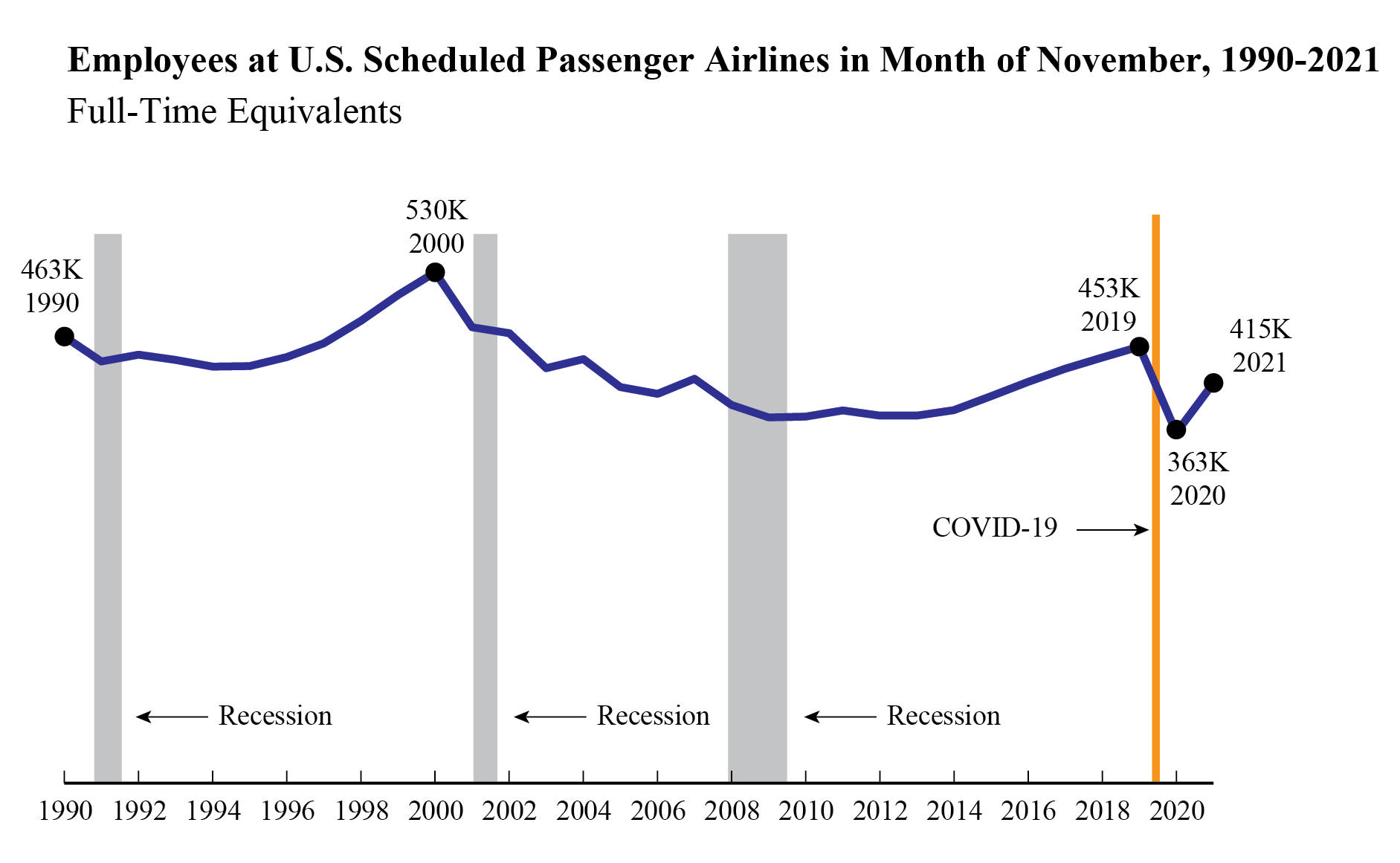Source: US DOT
The 24 U.S. scheduled passenger airlines employed 414,597 full-time equivalents (FTEs) in November 2021, 1,151 FTEs (0.3%) more than in October 2021. This is the seventh consecutive month-over-month increase in passenger airline FTEs, dating back to May 2021. November’s total number of FTEs remains down 37,472 FTEs (8.3%) from pre-pandemic November 2019’s 452,429 FTEs.
The employment increase from October was led by Delta Air Lines, which added 1,149 FTEs and Southwest Airlines, which added 536 FTEs. Those increases were moderated by United Airlines, which decreased employment by 1,087 FTEs. Low-cost carriers showed the greatest percent increase (1.0%) from October 2021 among passenger airline categories. Regional carriers are the only category showing a net increase in FTEs (0.6%) from pre-pandemic November 2019.
In November 2021, scheduled passenger airlines employed 63% of total airline industry FTEs, the same percentage as in March 2020 at the onset of the COVID-19 pandemic. Total industry includes cargo and charter.
Regulations require U.S. airlines to report employment numbers for employees who worked or received pay for any part of the pay period(s) ending nearest the 15th day of the month. U.S. airline employment reports are filed monthly with the Bureau of Transportation Statistics. See the tables that accompany this release on the BTS website for detailed data since 2015 (Tables 1-15) and industry summary monthly data since 1990.

Employment Breakdowns by Passenger Airline Category
All 24 scheduled service passenger airlines (mid-November)
- 414,957 FTEs
- Down 8.3% (37,472 FTEs) from November 2019 (452,429 FTEs)
- Up 14.2% (51,603 FTEs) from November 2020 (363,354 FTEs)
- Up 0.3% (1,151 FTEs) from October 2021 (413,806 FTEs)
Four network airlines (mid-November)
American Airlines, Delta Air Lines, United Airlines, Alaska Airlines
- 254,748 FTEs, 61.4% of total scheduled passenger airline FTEs
- Down 11.6% (33,399 FTEs) from November 2019 (288,147 FTEs)
- Up 16.9% (36,775 FTEs) from November 2020 (217,973 FTEs)
- Up 0.2% (392 FTEs) from October 2021 (254,356) FTEs
Network airlines operate a significant portion of their flights using at least one hub where connections are made for flights to down-line destinations or spoke cities. Note that beginning with January 2018 data, Virgin America’s numbers are included with Alaska Airlines in the network category.
Six low-cost airlines (mid-November)
Southwest Airlines, JetBlue Airways, Spirit Airlines, Frontier Airlines, Allegiant Air, Virgin America
- 92,614 FTEs, 22.3% of total scheduled passenger airline FTEs
- Down 5% (4,909 FTEs) from November 2019 (97,523 FTEs)
- Up 0.8% (709 FTEs) from November 2020 (91,905 FTEs)
- Up 1% (913 FTEs) from October 2021 (91,701) FTEs
Low-cost airlines operate under a low-cost business model, with infrastructure and aircraft operating costs below the overall industry average.
Ten regional airlines (mid-July)
SkyWest Airlines, Envoy Air, Piedmont Airlines, Republic Airlines, Endeavor Air, PSA Airlines, Horizon Air, Mesa Airlines, Air Wisconsin Airlines, GoJet Airlines
- 58,886 FTEs, 14.2% of total scheduled passenger airline FTEs
- Up 0.6% (356 FTEs) from November 2019 (58,530 FTEs)
- Up 26.3% (12,259 FTEs) from November 2020 (46,627 FTEs)
- Down 0.3% (193 FTEs) from October 2021 (59,079 FTEs)
Regional carriers typically provide service from small cities, using primarily regional jets to support the network carriers’ hub and spoke systems.
Top Employers by Group
- Network: American 91,819 FTEs
- Low-Cost: Southwest 54,594 FTEs
- Regional: SkyWest 14,430 FTEs
Four other airlines included in industry totals
Other carriers generally operate within specific niche markets. They are Hawaiian Airlines, Sun Country Airlines, Silver Airlines and Eastern Airlines.
Reporting Notes
Airlines that operate at least one aircraft that has more than 60 seats or the capacity to carry a payload of passengers, cargo and fuel weighing more than 18,000 pounds must report monthly employment statistics.
